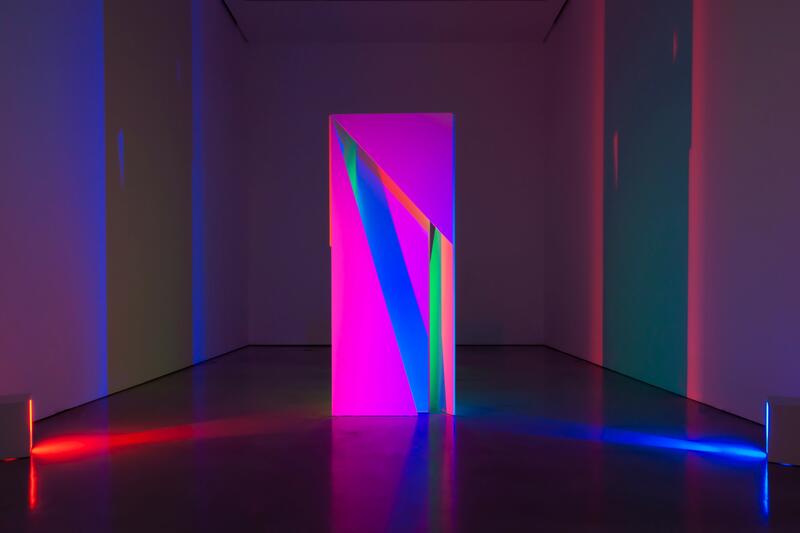DAVID MAGÁN'S INTERACTIVE ART
After the solo exhibition Matter Matters at the Centro de Arte Caja de Burgos (CAB), David Magán inaugurated the projects Hard-line and Light Object at Galería Cayón space. Conceived to occupy both gallery spaces independently, the exhibition takes on a double character: on the one hand, a series of sculptural artworks that function as a single oeuvre and that deepen Magán's link with the use of line; on the other, an installation made especially for the second space that proposes to highlight the materiality of light through additive colour (the chromatic composition through the superimposition of red, blue and green).
Hard-line and Light Object were inaugurated on Saturday 13 March in the two spaces of Galería Cayón located at Calle de Blanca Navarra 7 and Calle de Blanca Navarra 9, where they will remain until 23 of April. This is the fourth opportunity for David Magán (Madrid, 1979) to present his work individually at the Madrid gallery.

The works presented by David Magán at the Galería Cayón have two substantial values. Firstly, the dialogue that the Spanish artist establishes with a whole tradition of abstract, kinetic, minimalist and Op-art, and secondly, the capacity of all the artworks on display to question the visitor, situating him or her within the artistic process. Although the works that occupy the two spaces were conceived independently, both respond to these two axes.
In the first case, what Magán does is not to reproduce the treatments that figures such as Ellsworth Kelly, Frank Stella, Sol Lewitt or even Jesús Rafael Soto and Julio Leparc —all of whom are present in his work— employed in their careers, but to appropriate and reconfigure them, taking his artwork into new terrain. As Javier del Campo describes it in the Matter Matters catalogue produced by the CAB: "[David Magán] investigates knowing the state of the art, the contributions, the discoveries and also the failed results in more than a hundred years of experience in kinetic and optical art". The artist from Madrid absorbs all this and what his work becomes is, in short, "an emancipated proposal".[1]
Thus, the seven artworks from the series Línea Vacía (Empty Line) that make up the exhibition in the first space are sculptural objects where the presence of the line makes them oscillate constantly between drawing and sculpture. The line adopts a leading role in the pieces, revealing and concealing, establishing ambiguities in the spectator: including him. This inclusion is given by the movement of the spectator himself and the transformations that the objects produced by Magán establish in relation to the visitor. And this brings us directly to the second question of Hard-line and Light Object.
-
"Hard-line", David Magán, exhibition view. Ph: Estudio David Magán.
-
"Hard-line", David Magán, exhibition view. Ph: Estudio David Magán.
-
"Hard-line", David Magán, exhibition view. Ph: Estudio David Magán.
-
"Hard-line", David Magán, exhibition view. Ph: Estudio David Magán.
-
"Hard-line", David Magán, exhibition view. Ph: Estudio David Magán.
-
"Hard-line", David Magán, exhibition view. Ph: Estudio David Magán.
The experience produced by the installation —Light Object 01— located in the second space of the gallery is very illustrative. This piece has been conceived on the basis of Magán's obsession with exhibiting the physicality of light, that is to say, its material capacity. The fact of doing so by means of an installation does not seem gratuitous. "Traditional artistic media are defined by a specific material support: canvas, marble or film", writes Groys in Politics of Installation, and continues: "The material support of the installation medium is space itself (...) installation is material par excellence since it is spatial and its being in space is the most general definition of material being."
The work that stands in the centre of the dark room is exposed to three halos of light that respond to the RGB system. The piece stands in the centre as if it were a totem pole. The space is monopolised by its presence, and as the spectator advances and surrounds it, the combination and frequencies of light, perceived from different angles, cover each fold and each intersection of planes with a singular range of colour which, in turn, appear and disappear with the very shadow of the person interacting with it.
However, something similar happens in the methacrylate diptychs in the first room. The artist composes identical pieces with the same materials, but what he does is to superimpose the plates differently. Thus, the chromatic compositions differ; the only way to understand it is to get closer, to shorten the distance between the artistic object and the observer. It is as soon as we assume this attitude that the work reveals to us, through the line, the arrangement of the methacrylates; it reveals to us its operation.
-
"Light Object", David Magán, exhibition view. Ph: Estudio David Magán.
-
"Light Object", David Magán, exhibition view. Ph: Estudio David Magán.
-
"Light Object", David Magán, exhibition view. Ph: Estudio David Magán.
-
"Light Object", David Magán, exhibition view. Ph: Estudio David Magán.
-
"Light Object", David Magán, exhibition view. Ph: Estudio David Magán.
Hard-Line and Light Object propose a game. Magán proposes a game, and with it we complete the artwork. The genius of the two exhibitions on show at Galería Cayón lies there, in making us, obligatorily, participants in David Magán’s composition and artistic language. Even almost without us being aware of it.
[1] Política de la instalación, Boris Groys, en Volverse público. Las transformaciones del arte en el ágora contemporáneo; Caja Negra, 2016. (Author transalation).




